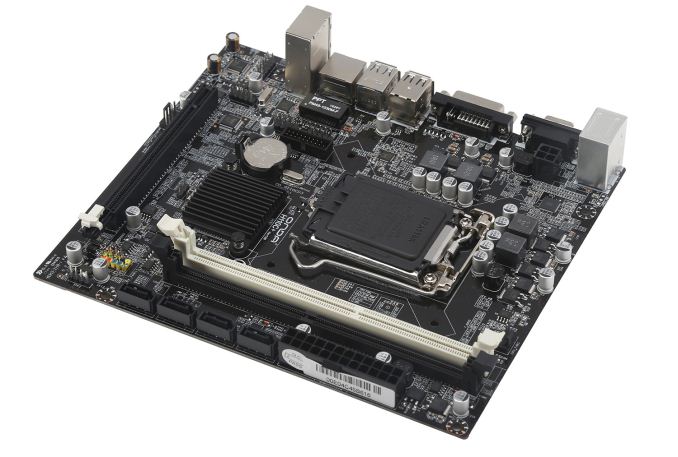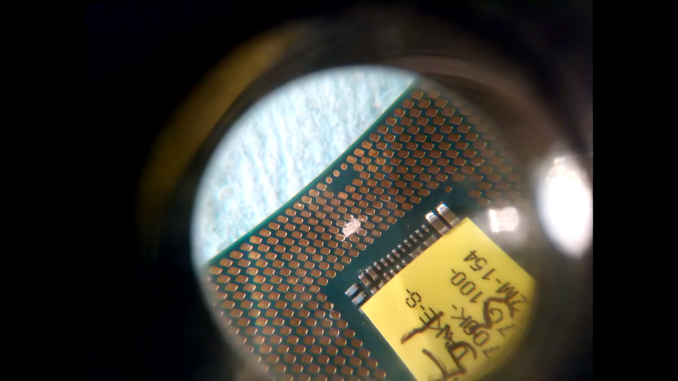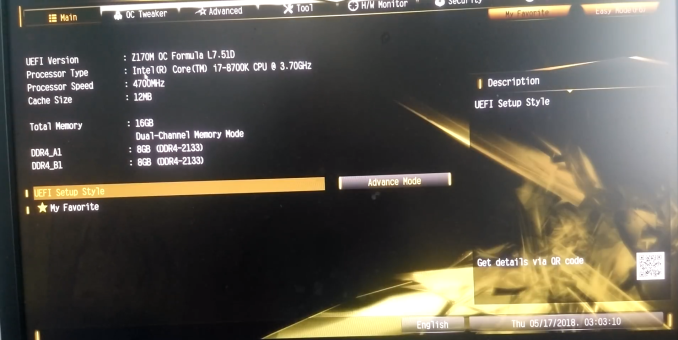PC Supplier Adds Support for Coffee Lake CPUs to Older Intel H110 Platforms
by Anton Shilov on August 19, 2018 12:15 PM EST- Posted in
- Motherboards
- Intel
- Onda
- H110
- Coffee Lake

A supplier of PCs from China has added support for Intel’s Coffee Lake CPUs to its platforms based on Intel’s H110 chipset. The announcement does not mean that mainboards from other brands can work with Intel’s latest CPUs, but certainly raises questions.
Onda, a supplier of computers from China, tweeted that its H110C+ (rev. 1.00) mainboards now support Intel’s Core i3-8100 and Core i3-8350K processors. Both CPUs belong to the Coffee Lake family, which uses a different power delivery method than processors which belong to the Skylake and Kaby Lake families (please check our Coffee Lake review for details). Yet, the producer of motherboards found a way to support Intel’s latest CPUs on its entry level platforms, we assume, by adjusting the firmware to detect and change the identification pins. Other considerations have to be in place as well, such as VRM temperatures and power delivery - the listing does not show support for the Core i7-8700K for example, which has much higher power delivery requirements.
Running a Coffee Lake CPU on motherboards featuring the LGA1150 v1 socket is not exactly surprising. Enthusiasts have managed to work the latest parts on older platforms, such as onto the ASRock Z170 OC Formula, but this requires adjusting the pin pads on the bottom of the processor.
Onda, by contrast, is the first company to announce the support with publically available firmware.
Related Reading
- ASRock Confirms Eight-Core Coffee Lake CPUs, Adds Their Support to Intel 300-Series Boards
- ASUS Adds Support for 9th Gen Core CPUs to Their Intel 300-Series Motherboards
- GIGABYTE Adds Support for Intel’s 9th Gen Core Processors to Existing Motherboards
- MSI Z370 Motherboards Now Support Intel’s 9th Gen Core CPUs
- Analyzing Z370 for Intel's 8th Generation Coffee Lake: A Quick Look at 50+ Motherboards
- Intel 8th Generation and 9th Generation Processor Lists Leaked: Coffee Lake Refresh?
- Intel Outs Z390 & X399 PCHs for Cannon Lake & Coffee Lake CPUs
- Intel Documents Point to AVX-512 Support for Cannon Lake Consumer CPUs
- Intel Officially Reveals Post-8th Generation Core Architecture Code Name: Ice Lake, Built on 10nm+
- ASUS Publishes List of Upcoming Intel Z390-Based Motherboards
- MSI Z370 Motherboards Now Support Intel’s 9th Gen Core CPUs













15 Comments
View All Comments
Spunjji - Monday, August 20, 2018 - link
Options at the customer's own risk are good; enforced lack of options is bad. The kind of person who is going to mess that up is also the kind of person who isn't going to try in the first place.mkaibear - Monday, August 20, 2018 - link
Have you *met* the general public? They will not only try in the first place, they will rant about how Intel sold them stuff which didn't work. It will never be their fault for not checking, it will always be the fault of the manufacturer."It's the same socket it should just work" never mind all the additional power stuff which is necessary to support it.
Options at the customer's own risk are not good. They lead to angry customers, angry resellers, and huge costs for the manufacturer.
And how do we know this? Well, it happened, to Intel, between 2004 and 2008. Do you not remember what happened with the LGA 775 sockets? Different chips with different power consumptions didn't work in some motherboards and did in others, it all got dumped on Intel as it was "their fault" and they ended up publishing big lists of what did and didn't work across motherboards. Nevertheless they ended up getting it in the neck.
Damned if they do and damned if they don't.
edzieba - Monday, August 20, 2018 - link
Bingo. The irony is, if Intel inflated costs by shifting one of the socket notches and adding one NC pin (to make Socket H4 or 'LGA 1152') - meaning money wasted on new mouldings, new machinery, and new qual testing - then the entire furore would not exist.Kvaern1 - Monday, August 20, 2018 - link
Bullshit excuse. They could release the appropriate firmware updates to the motherboard vendors and have them sort power compatibility out themselves.mkaibear - Monday, August 20, 2018 - link
Er, firmware updates can't fix physical problems, like the power supplies not being able to push out enough clean enough power.Besides, that's exactly what Intel did back in the '00s, with socket 775 as I said - even with Intel providing all the info to motherboard vendors and the general public Intel still got it in the neck for supplying products which weren't compatible. Back then everyone was saying Intel should have simply said they wouldn't work... comme ci comme ca!